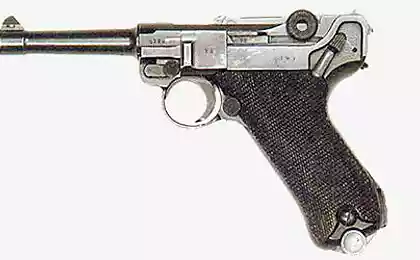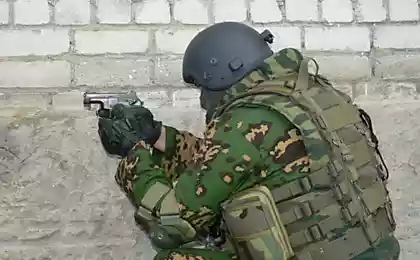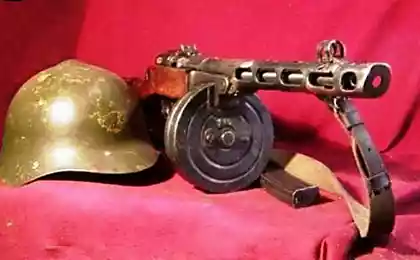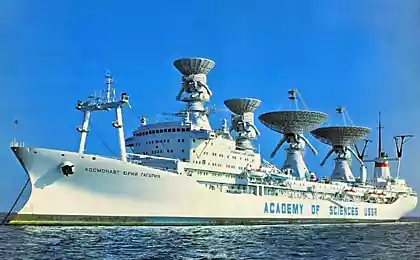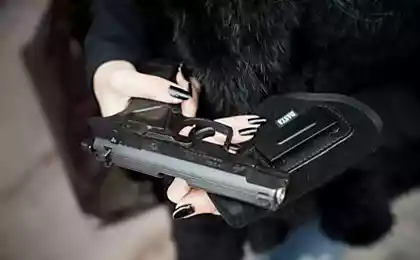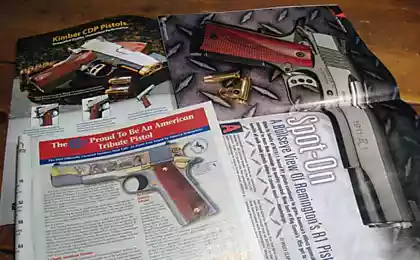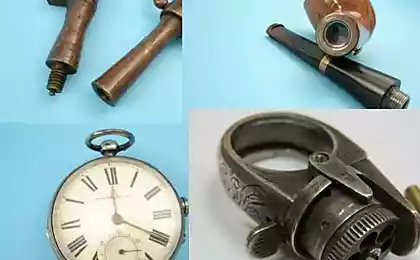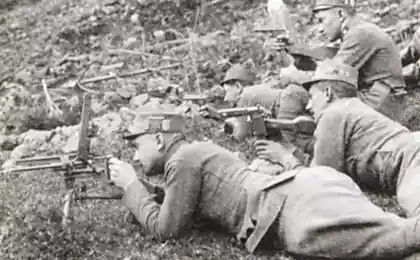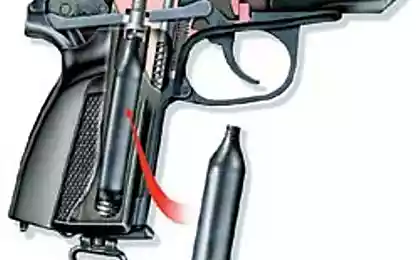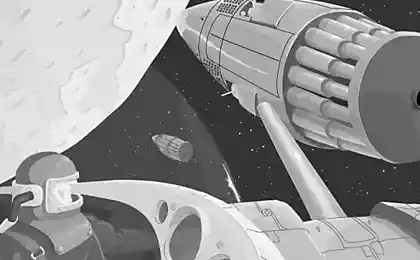1200
Made in USSR
Let's see what weapons would wield a Soviet cosmonaut on a plan of scientists of the time ...
First flown in space weapon became a Makarov pistol, a member of the emergency reserve cosmonaut since Yuri Gagarin's flight. Since 1982, it has replaced specifically designed for survival and self-defense in a contingency emergency landing SONAZ - "small arms portable emergency", known also under the designation TA-82, triple-gun astronaut.

The Americans approached the problem easier and decided to equip its astronauts classic knives for survival, dubbed «Astro 17" and in the style of the legendary Bowie knife.
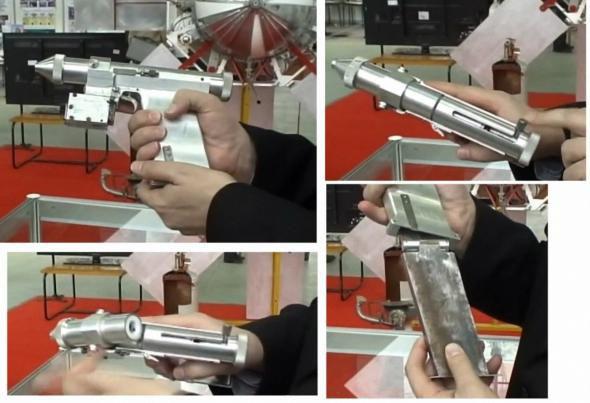
The first attempts to create weapons, damaging factor which is a laser beam were made back in the 1970s, both the US and the USSR. However, this problem has been slozhnorealizuemoy taking into account scientific and technical progress of the time. During the development of the Soviet Union it was initially decided that the weapons would not be lethal. Its main purpose is self-defense, and disabling the electronic and optical systems of the enemy.
In 1984, the program "Diamond" for the protection of similar Soviet OPS (manned orbital station) and DOS (long-term manned stations) "Salute" from the satellite-inspectors and interceptors potential opponent in the Military Academy of the Strategic Missile Forces (RVSN) was developed by -This is a fantastic weapon - fiber laser pistol.
The research team led by the Head of the Department, Honored Scientist of the RSFSR, Doctor of Technical Sciences, Professor, Major-General Victor Samsonovich Sulakvelidze. Theoretical and experimental studies of the harmful effect of the laser gun was engaged doctor of technical sciences, professor Boris Duvanov. Above the working drawings researcher AV Simonov participated in the trials researcher LI Avakyants and adjunct VV Gorev.
The designers set out to develop a compact weapon for disabling the optical systems of the enemy.
Prototypes of laser weapons. From left to right: singly charged Laser Gun, Laser gun, laser gun.
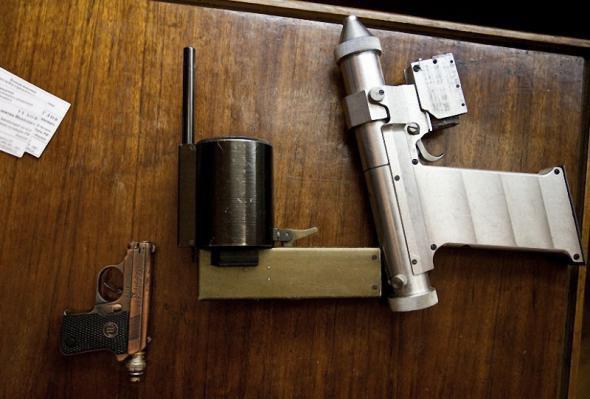
In the first phase of the future development of the authors have found that sufficient for this purpose a relatively small energy radiation - in the range of 1 - 10 J. (By the way, and allowing blind the enemy).
As a source of optical pumping were used pyrotechnic flash lamp having enough energy and at the same time very compact.
The scheme of work was simple and reliable: pyrotechnic flash lamp repeats the structure of a conventional 10 mm caliber cartridge that is placed shutter of a shop in the chamber, which is a light box. By piezo-electric pulse in the cartridge ignites the mixture of zirconium salts and metal foil. The result is a flash with a temperature of almost 5000 ° C, this energy is absorbed by the optical elements of the gun facing the camera for lighting and converted into a pulse. Weapons 8 charger is not automatic - reload manually. Killability released beam - up to 20 meters.

Also developed a laser gun, which is in contrast to the gun has the ability to self-cocking firing, but was 6 charges.
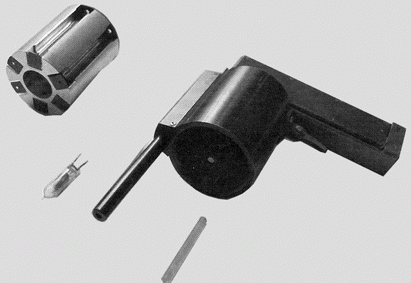
The main elements of the laser gun as any laser became active medium, pump source and an optical resonator.
The medium designers have selected the crystal yttrium-aluminum garnet, generates a beam in the infrared range at a relatively low pump power. Spraying its ends serves as a resonator mirror. For optical pumping of used small-sized discharge lamp-flash. Since even the smallest power supply weighed 3 - 5 kg, it had to be placed separately from the gun.
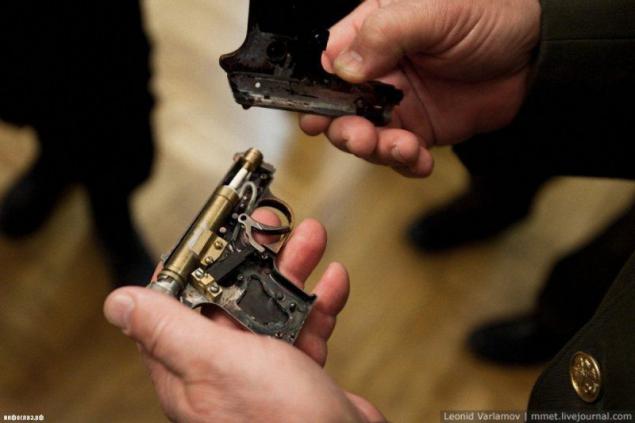
In the second phase it was decided to replace the active medium in the fiber optic elements - in them, as in the garnet crystal, radiation initiated neodymium ions. Because the diameter is the "thread" is about 30 microns, and the surface of the collected of its segments (from 300 to 1000 pcs.) Harness was great, the lasing threshold (smallest pump energy) decreased to the same becomes unnecessary cavities.
The matter remained a source of small-sized optical pumping. In his capacity as the decision was made to use a disposable fireworks flash lamp.
Each cylinder was placed desyatimillimetrovom pyrotechnic mixture - zirconium foil, oxygen and a metal salt and covered with combustible paste tungsten-rhenium wire for its ignition.
Set on fire by an electric spark from an external source such lamp burns 5-10 milliseconds at a temperature of about 5000 degrees Kelvin. Through the use of zirconium foil specific light energy pyrotechnic lamp three times higher than that of conventional designs that use magnesium. Added to the mixture of the metal salt "customize" light bulb to the absorption spectrum of the active element. Pyrotechnic mixture of non-toxic and is not subject to spontaneous detonation.

Eight flash lamps disposed in a store, similar fire-gun cartridges. After each "shot" expended light emitted, like a sleeve, and in the light box is served next munition. The energy source for the electric ignition is attached to a special guide under the barrel-type battery "Krona».
Fiber-optic active element absorbs radiation from the burning lamp, causing it to laser pulse is directed through the barrel of a gun at a target.
Released from a barrel beam retains its scorching and blinding effect on the distance of 20 meters.
On the basis of the laser gun with a pyrotechnic flash lamp was constructed and a laser gun with drum magazine capacity of 6 rounds and singly charged Lady laser pistol.
The developers have stated the possibility of modifying the pistol of military weapons in the medical instrument (apparently, it took a replacement source of optical pumping).
All experimental work was done manually. Upon completion of studies at one of the companies already was adjusted serial production of the lamps, but the conversion of the defense industry put an end to the development of the project. The product line was terminated, however, the work of inertia is still ongoing, but until then, until the end of the stock produced lamps.
Currently, laser pistol with a pyrotechnic flash lamp recognized as a monument of Science and Technology of the 1st category and is exhibited in the Museum of the Military Academy of Strategic Missile Forces of Peter the Great.
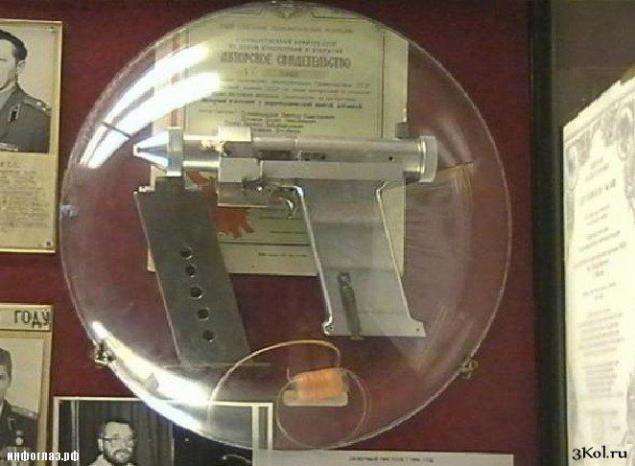
Source:
First flown in space weapon became a Makarov pistol, a member of the emergency reserve cosmonaut since Yuri Gagarin's flight. Since 1982, it has replaced specifically designed for survival and self-defense in a contingency emergency landing SONAZ - "small arms portable emergency", known also under the designation TA-82, triple-gun astronaut.

The Americans approached the problem easier and decided to equip its astronauts classic knives for survival, dubbed «Astro 17" and in the style of the legendary Bowie knife.

The first attempts to create weapons, damaging factor which is a laser beam were made back in the 1970s, both the US and the USSR. However, this problem has been slozhnorealizuemoy taking into account scientific and technical progress of the time. During the development of the Soviet Union it was initially decided that the weapons would not be lethal. Its main purpose is self-defense, and disabling the electronic and optical systems of the enemy.
In 1984, the program "Diamond" for the protection of similar Soviet OPS (manned orbital station) and DOS (long-term manned stations) "Salute" from the satellite-inspectors and interceptors potential opponent in the Military Academy of the Strategic Missile Forces (RVSN) was developed by -This is a fantastic weapon - fiber laser pistol.
The research team led by the Head of the Department, Honored Scientist of the RSFSR, Doctor of Technical Sciences, Professor, Major-General Victor Samsonovich Sulakvelidze. Theoretical and experimental studies of the harmful effect of the laser gun was engaged doctor of technical sciences, professor Boris Duvanov. Above the working drawings researcher AV Simonov participated in the trials researcher LI Avakyants and adjunct VV Gorev.
The designers set out to develop a compact weapon for disabling the optical systems of the enemy.
Prototypes of laser weapons. From left to right: singly charged Laser Gun, Laser gun, laser gun.

In the first phase of the future development of the authors have found that sufficient for this purpose a relatively small energy radiation - in the range of 1 - 10 J. (By the way, and allowing blind the enemy).
As a source of optical pumping were used pyrotechnic flash lamp having enough energy and at the same time very compact.
The scheme of work was simple and reliable: pyrotechnic flash lamp repeats the structure of a conventional 10 mm caliber cartridge that is placed shutter of a shop in the chamber, which is a light box. By piezo-electric pulse in the cartridge ignites the mixture of zirconium salts and metal foil. The result is a flash with a temperature of almost 5000 ° C, this energy is absorbed by the optical elements of the gun facing the camera for lighting and converted into a pulse. Weapons 8 charger is not automatic - reload manually. Killability released beam - up to 20 meters.

Also developed a laser gun, which is in contrast to the gun has the ability to self-cocking firing, but was 6 charges.

The main elements of the laser gun as any laser became active medium, pump source and an optical resonator.
The medium designers have selected the crystal yttrium-aluminum garnet, generates a beam in the infrared range at a relatively low pump power. Spraying its ends serves as a resonator mirror. For optical pumping of used small-sized discharge lamp-flash. Since even the smallest power supply weighed 3 - 5 kg, it had to be placed separately from the gun.

In the second phase it was decided to replace the active medium in the fiber optic elements - in them, as in the garnet crystal, radiation initiated neodymium ions. Because the diameter is the "thread" is about 30 microns, and the surface of the collected of its segments (from 300 to 1000 pcs.) Harness was great, the lasing threshold (smallest pump energy) decreased to the same becomes unnecessary cavities.
The matter remained a source of small-sized optical pumping. In his capacity as the decision was made to use a disposable fireworks flash lamp.
Each cylinder was placed desyatimillimetrovom pyrotechnic mixture - zirconium foil, oxygen and a metal salt and covered with combustible paste tungsten-rhenium wire for its ignition.
Set on fire by an electric spark from an external source such lamp burns 5-10 milliseconds at a temperature of about 5000 degrees Kelvin. Through the use of zirconium foil specific light energy pyrotechnic lamp three times higher than that of conventional designs that use magnesium. Added to the mixture of the metal salt "customize" light bulb to the absorption spectrum of the active element. Pyrotechnic mixture of non-toxic and is not subject to spontaneous detonation.

Eight flash lamps disposed in a store, similar fire-gun cartridges. After each "shot" expended light emitted, like a sleeve, and in the light box is served next munition. The energy source for the electric ignition is attached to a special guide under the barrel-type battery "Krona».
Fiber-optic active element absorbs radiation from the burning lamp, causing it to laser pulse is directed through the barrel of a gun at a target.
Released from a barrel beam retains its scorching and blinding effect on the distance of 20 meters.
On the basis of the laser gun with a pyrotechnic flash lamp was constructed and a laser gun with drum magazine capacity of 6 rounds and singly charged Lady laser pistol.
The developers have stated the possibility of modifying the pistol of military weapons in the medical instrument (apparently, it took a replacement source of optical pumping).
All experimental work was done manually. Upon completion of studies at one of the companies already was adjusted serial production of the lamps, but the conversion of the defense industry put an end to the development of the project. The product line was terminated, however, the work of inertia is still ongoing, but until then, until the end of the stock produced lamps.
Currently, laser pistol with a pyrotechnic flash lamp recognized as a monument of Science and Technology of the 1st category and is exhibited in the Museum of the Military Academy of Strategic Missile Forces of Peter the Great.

Source:
